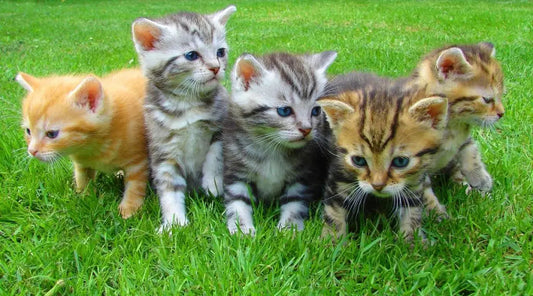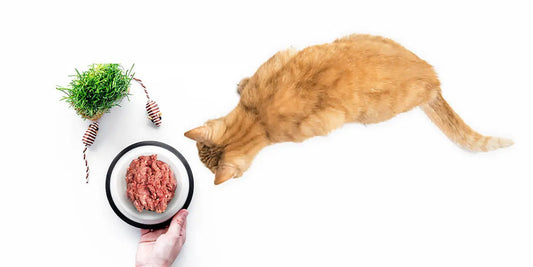
Can Cats Eat Salmon Safely? What Every Pet Owner Should Know
With its glistening pink color and flaky texture, salmon might be one of the most appetizing foods around. And as it turns out, humans aren’t alone in thinking that—cats also adore salmon, and will jump at the chance to scarf down some savory slices.
But can cats have salmon? After all, humans sometimes crave unhealthy foods—it’s fair to wonder if cats share that trait.
The good news is that it’s perfectly fine to serve your cat salmon. In fact, salmon comes loaded with vitamins and nutrients that can boost cat health and happiness.
Is Salmon Safe for Cats?
So, should cats eat fish? For most cats, salmon poses no danger when consumed in moderation. However, it’s important to keep a few guidelines in mind:
-
Avoid smoked or seasoned varieties – Lots of artificial additives or heavy seasoning (like garlic or chives) can cause gastric distress for your cat. Smoked salmon also packs a ton of cat, which is a no-go for cats.
-
Choose high-quality raw salmon – Since spices are out, you might wonder: Can cats eat raw salmon? The answer is yes (their wild ancestors would have eaten raw fish daily), but always choose the highest-grade raw, as low-end varieties can carry parasites.
-
Watch for bones – Salmon bones are tiny, and cats can easily pass them the majority of the time. It’s possible, however, for bones to get caught in the throat or digestive system and cause lesions. Keep an eye out for any signs of post-salmon distress.
-
Beware of food allergies – Fish agrees with most cats. However, some cats do harbor allergies. If, after dining on salmon, your cat develops itchy skin, begins vomiting, or experiences diarrhea, you may have an allergy on your hands.
-
Practice moderation – While it offers plenty of benefits, too much salmon can trigger digestive upset. What’s more, overconsumption of salmon can contribute to obesity.
Ultimately, with diligence and sound product choices, you can safely serve your cat salmon—and your cat can reap its nourishing rewards.
The Nutritional Benefits of Salmon for Cats
So, it’s safe for cats to eat—but is salmon good for cats?
Yes! As obligate carnivores, cats require ample meat in their diet. High-protein and low-calorie varieties, like salmon, deliver what cats need to thrive.
Beyond protein content, salmon offers a host of additional benefits for your feline friend:
-
Sharper vision – Salmon comes loaded with omega-3s, which support healthy cells, reduce inflammation, and help alleviate dry-eye symptoms. Cats lean on their acute vision to navigate the world, making it all the more critical to keep their eyes in optimal condition.
-
Shiny coat and resilient skin – Salmon’s omega-3s also keep skin supple and moisturized. If your cat struggles with flaky skin or patchy fur, adding a touch of salmon to their diet may help alleviate these symptoms. The added fish oil content in salmon plays a key role in supporting these benefits.
-
Reduced inflammation – Omega-3s are also a potent anti-inflammatory. They can help soothe symptoms of arthritis and ward off disease as your feline ages.
-
Healthy brain and nervous system – Salmon contains scores of fatty acids that help support cognition and your cat’s overall nervous system. These ingredients work together to support long-term cat health.
With a nutrient profile that’s far from one-dimensional, salmon offers enormous benefits for cats both young and old. For general health support, salmon’s hard to top.
Potential Risks of Salmon for Cats
To be clear: The vast majority of cats stand to gain plenty from salmon. But a minority may struggle to process or integrate it with the rest of their diet.
We’ve already covered basic safety when serving your cat salmon, but it’s equally important to talk about the subtler risks salmon could pose:
-
Imbalanced nutrition – Cats, as obligate carnivores, primarily rely on animal tissue for their protein and nutrients. Think of meats like chicken and turkey. While salmon offers a broad nutrient profile, it shouldn’t replace core protein sources. It’s one of many types of fish that should only serve as a supplement to their primary protein intake.
-
Sodium overload – Cats who dine on a steady diet of canned or smoked salmon may develop elevated sodium levels. Symptoms of this include dehydration, vomiting, fatigue, and diarrhea. Avoid sodium overload by sticking with fresh, unprocessed varieties that skip the salt.
-
Thiamin deficiency – Thiamin, a member of the vitamin B family, helps regulate the feline metabolism. Fish contains an enzyme called thiaminase, which can dull the body’s natural thiamin production and lead to poisoning over time.
-
Heavy metal accumulation – Relative to other fish varieties (like tuna), salmon boasts low mercury and heavy metal levels. However, it still contains trace amounts. In excess, salmon can expose your cat to unsafe mercury levels over time. A licensed veterinarian can help you determine if your cat’s seafood intake is safe.
As a safer alternative for everyday feeding, consider incorporating freeze-dried salmon cat treats, which offer clean nutrition without the risks associated with processed fish.
Remember: These downsides are rare and easy to avoid. If you integrate salmon in the proper amounts and only choose high-quality products, you can ensure your cat enjoys this savory dish and stable health.
How to Serve Salmon to Your Cat Safely
To sidestep any safety or health issues, always follow proper preparation and serving guidelines. Start with unseasoned, high-quality salmon. Make sure to thoroughly clean and debone it (take your time with this—salmon bones can be tiny and hard to spot).
Here’s our advice for optimal preparation:
-
Lay the fillet flat, skin-side down
-
Run your fingers over the fillet and feel for protruding bones
-
Grab some pliers or tweezers and gently pluck out any bones you encounter
-
Check your work by running your fingers across the fillet again
With a little practice, deboning can become second nature and won’t take you more than a few minutes. Once your salmon is prepped, you can either serve it raw or cook it. Feeding fish raw can mimic a cat’s natural habits, but always ensure safety and quality.
If you decide to cook your salmon, we recommend one of the following methods:
-
Baking – Preheat your oven to 400 degrees. Lay the salmon on a baking sheet and bake for 12-15 minutes.
-
Grilling – Let your pan warm over medium heat. Add the salmon and cook until it starts flaking at the slightest touch.
-
Boiling – Bring water to a simmer, insert the salmon, and let it boil for 5-8 minutes until flaky and tender.
After cooking, let your salmon cool and divide it into cat-sized portions. Consider leaving the salmon skin on—it’s packed with nutrients and omega-3s that contribute to healthy skin and coat. For pet parents looking for convenient, shelf-stable options, freeze-dried minnows and salmon cat treats can offer many of the same nutrients with far less prep.
Tips for a Well-Rounded Cat Diet
Salmon serves as an excellent complement to a healthy feline menu. But the best way to maximize salmon’s benefits? Craft a balanced overall diet that nourishes your cat from the inside out and keeps them aligned with their ancestral nature.
If you’re taking the first steps to create a diet that looks beyond commercial pet food and canned feeding, information overload can be a real struggle. That’s why Darwin’s is here to help.
To treat your cat to a healthy, ancestral diet with minimal fuss:
-
Select quality raw food – Get your cat in tune with their natural rhythm by choosing a premium raw food brand. Darwin’s Natural Selections fresh cat food line provides full-spectrum cat nutrition, free of hormones and harmful additives.
-
Start slow – Although raw, ancestral diets offer vastly improved nutrition, a sudden switch to your cat’s diet isn’t ideal. Instead, start slow. Introduce raw food in smaller increments and gradually phase out commercial kibble.
-
Establish a feeding schedule – By training your cat to anticipate food at certain times, you can ensure a solid appetite, which helps entice picky eaters.
-
Try hand feeding – Some cats prefer the familiar and will hesitate to jump to raw food. Hand feeding small portions of raw food can help ease the transition and reassure skittish felines. Plus, it makes for an excellent bonding opportunity.
-
Choose a “safe” area – Switching diets can cause anxiety in some cats. Soothe their nerves by serving unfamiliar food in a calm, traffic-free spot. To avoid overstimulation, keep other pets away during these early mealtimes.
Additionally, it’s best practice to follow a precise raw cat food transition plan. For instance:
-
Days 1-3 – Mix in 25% raw food and 75% commercial cat food (or whatever blend they’re used to).
-
Days 4-6 – Switch to a 50/50 mix.
-
Days 7-9 - Expand to 75% raw, 25% commercial.
-
Day 10 and beyond – Graduate your cat to 100% raw, and prepare to watch them thrive.
As you guide your cat through the transition, consider cutting back on treats. This will help ensure your cat is hungry at mealtimes and keeps them focused on their fresh fare.
When you do add treats, go with healthy options, like Darwin’s Freeze-Dried Raw Salmon Bites. Crafted with human-grade salmon and supremely shelf-stable, they make for mouth-watering goodies and mealtime toppers. If you’re wondering, are freeze-dried minnows good for cats? The answer is yes—these cat treats offer concentrated protein and omega-3s in every crunchy bite.
Trust Darwin's Natural Pet Products for Quality Nutrition
Dining on salmon helps cats satisfy their inner hunter. And as they get in touch with their ancestral side, their zest for life will grow. When combined with a clean, raw diet, you have a surefire recipe for a flourishing feline.
At Darwin’s Natural Pet Products, we strive to help pets of all stripes thrive. Our menu of premium raw cat food, packed with core nutrients and crafted with free-range meats, provides complete nutrition perfectly aligned with ancestral needs.
Every day, you savor the joy your pets bring into your life—it’s only natural to want to return the favor. Help your cat (or dog) answer the call of the wild. Reach out today for a free dietary consultation.
Sources:
- Doylestown Veterinary Hospital. The Top Foods and Spices Your Pets Should Avoid. https://www.doylestownveterinaryhospital.com/blog/foods-and-spices-your-pets-should-avoid/
- UC Davis Veterinary Medicine. Role of Diet in the Health of the Feline Intestinal Tract and in Inflammatory Bowel Disease. https://ccah.vetmed.ucdavis.edu/sites/g/files/dgvnsk4586/files/inline-files/role-of-diet-feline-health-Glasgow_0.pdf
- Washington State Department of Health. Farmed Salmon vs. Wild Salmon. https://doh.wa.gov/community-and-environment/food/fish/farmed-salmon
- Cleveland Clinic. Omega-3 Fatty Acids. https://my.clevelandclinic.org/health/articles/17290-omega-3-fatty-acids
- Healthline. The 11 Best Foods for Healthy Skin. https://www.healthline.com/nutrition/12-foods-for-healthy-skin#1-Fatty-fish
- National Library of Medicine. Omega-3 fatty acids in inflammation and autoimmune diseases.
https://pubmed.ncbi.nlm.nih.gov/12480795/
- Northwestern Medicine. Best Foods for a Healthy Brain. https://www.nm.org/healthbeat/healthy-tips/nutrition/best-food-for-a-healthy-brain
- UC Davis Veterinary Medicine. Diet is critical to the health of a cat's intestinal tract.
https://ccah.vetmed.ucdavis.edu/cats/cat-health
- Spot Pet Insurance. Sodium Poisoning in Cats. https://spotpet.com/blog/cat-tips/sodium-poisoning-in-cats
- National Institutes of Health. Thiamin. https://ods.od.nih.gov/factsheets/Thiamin-HealthProfessional/
- Schwarzman Animal Medical Center. Thiamine Deficiency in Cats: Q&A for Cat Families. https://www.amcny.org/blog/2013/03/20/thiamine-deficiency-in-cats-q-a-for-cat-families/
- Creme de la Crumb. Best, Easy Healthy Baked Salmon Recipe.
https://www.lecremedelacrumb.com/best-easy-healthy-baked-salmon/
- The Mediterranean Dish. Simple Poached Salmon. https://www.themediterraneandish.com/poached-salmon/
- WebMD. Health Benefits of Smoked Salmon.
https://www.webmd.com/diet/health-benefits-smoked-salmon


